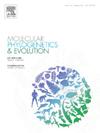Unraveling the potential structure of a Parnassius butterfly in Japan: Insights into the expansion history
IF 3.6
1区 生物学
Q2 BIOCHEMISTRY & MOLECULAR BIOLOGY
引用次数: 0
Abstract
The Japanese Archipelago consists of a series of isolated yet interconnected islands off the Eurasian continent. The linear topography of the archipelago presents a unique biogeographic context for the dispersal of organisms from the continent. In this study, mitochondrial DNA (mtDNA) and single-nucleotide polymorphism (SNP) variation were employed to elucidate the dispersal history of the Japanese clouded butterfly (Parnassius glacialis) across the Japanese Archipelago, including the northern island (Hokkaido), the main island (Honshu), and Shikoku Island. Network analysis of 1192 bp of mtDNA (cytochrome oxidase I and II) regions revealed 49 haplotypes and three distinct haplotype groups, which correspond geographically to Eastern Japan, Western Japan, and Chugoku–Shikoku. The Chugoku–Shikoku group is the most ancient lineage. Divergence time estimates using whole-genome sequencing of mtDNA suggest that the Japanese lineage diverged from the continental P. glacialis approximately 3.08 million years ago (Ma). Subsequently, the Eastern Japan and Western Japan lineages diverged from the Chugoku–Shikoku lineage around 1.06 Ma, with subsequent divergence of the Eastern and Western Japan lineages at approximately 0.62 Ma. P. glacialis is estimated to have expanded its distribution via a land bridge that once connected China and the Japanese Archipelago. Population structure analysis based on 3067 SNP genotypes revealed five distinct genetic structures within the Japanese Archipelago, indicating geographical differentiation. Through mtDNA and SNP variation analyses, four primary genetic barriers were identified: between Hokkaido and Honshu, between Eastern and Central Japan, within the Kansai region, and in the Chugoku region. The first three barriers correspond to notable geographical features, the Blakiston Line, a line parallel to the Itoigawa–Shizuoka Tectonic Line, and a boundary crossing Lake Biwa. These findings suggest that Japanese P. glacialis diverged from the continental P. glacialis and expanded its range across the Japanese Archipelago via western routes, leading to its current distribution.

揭开日本帕纳西斯蝴蝶的潜在结构:对扩张历史的洞察。
日本群岛由欧亚大陆外一系列孤立但相互连接的岛屿组成。群岛的线性地形为生物从大陆扩散提供了独特的生物地理环境。本研究利用线粒体DNA (mtDNA)和单核苷酸多态性(SNP)研究了日本云蝶(Parnassius glacialis)在日本列岛(包括北海道)、主岛(本州)和四国岛)的传播历史。对1192 bp的mtDNA(细胞色素氧化酶I和II)区域进行网络分析,发现49个单倍型和3个不同的单倍型群,在地理上分别对应于东日本、西日本和中国四国。Chugoku-Shikoku族是最古老的血统。利用mtDNA全基因组测序估计的分化时间表明,日本谱系大约在308万年前从大陆冰川种分离出来(Ma)。随后,东日本和西日本谱系在1.06 Ma左右从Chugoku-Shikoku谱系中分化出来,随后东日本和西日本谱系在约0.62 Ma时分化出来。据估计,冰川菌通过曾经连接中国和日本群岛的大陆桥扩大了分布范围。基于3067个SNP基因型的群体结构分析显示,日本列岛有5种不同的遗传结构,表明地理分化。通过mtDNA和SNP变异分析,鉴定出北海道和本州之间、日本东部和中部之间、关西地区内和Chugoku地区的4个主要遗传屏障。前三个屏障对应着显著的地理特征,即与伊藤-静冈构造线平行的Blakiston线和跨越琵浪湖的边界。这些发现表明,日本冰原菌是从大陆冰原菌中分化出来的,并通过西行路线在日本列岛扩大了活动范围,形成了目前的分布格局。
本文章由计算机程序翻译,如有差异,请以英文原文为准。
求助全文
约1分钟内获得全文
求助全文
来源期刊
CiteScore
7.50
自引率
7.30%
发文量
249
审稿时长
7.5 months
期刊介绍:
Molecular Phylogenetics and Evolution is dedicated to bringing Darwin''s dream within grasp - to "have fairly true genealogical trees of each great kingdom of Nature." The journal provides a forum for molecular studies that advance our understanding of phylogeny and evolution, further the development of phylogenetically more accurate taxonomic classifications, and ultimately bring a unified classification for all the ramifying lines of life. Phylogeographic studies will be considered for publication if they offer EXCEPTIONAL theoretical or empirical advances.

 求助内容:
求助内容: 应助结果提醒方式:
应助结果提醒方式:


